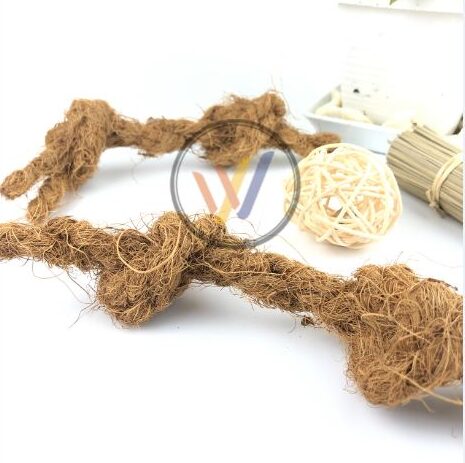BLOG
Coco Coir vs. Cotton: Which Pet Toy Is More Eco-Friendly?
Why Coco Coir Chew Toys Are More Environmentally Friendly Than Cotton Fiber Toys
As environmental sustainability becomes more important, eco-conscious pet owners seek ways to minimize their carbon footprint. One crucial decision involves choosing the right toys—not just for the health and enjoyment of their pets, but also for the planet. This blog compares the environmental impact of two popular materials used in pet toy production: coconut coir and cotton fiber. You’ll learn why Coco Coir Chew Toys are a superior choice for environmentally minded pet owners.
The Environmental Impact of Coconut Coir
Coconut coir comes from the fibrous husk of coconuts, an abundant byproduct of the coconut industry. Many manufacturers now repurpose these fibers to create sustainable products like pet toys.
- Renewable Resource: Coconuts grow abundantly in tropical regions and producers harvest them frequently. Using coir fibers, which are byproducts, helps reduce waste rather than depleting natural resources.
- Low Water and Pesticide Use: Coconut palms require minimal water and fertilizers. Unlike cotton, which demands heavy irrigation and pesticide application, coconut farming imposes a much lower environmental burden.
- Biodegradable: Once your Coco Coir Chew Toy reaches the end of its life, it decomposes naturally. This avoids contributing harmful microplastics or pollutants to the environment.
- Carbon Footprint: Using coconut coir reduces the need for new raw materials, lowering the carbon footprint. Additionally, the production processes for coir consume less energy than those for cotton.
The Environmental Impact of Cotton Fiber
Cotton fiber is widely used in consumer products, including pet toys. Although people often perceive cotton as a natural and sustainable material, its production involves significant environmental costs.
- High Water Consumption: Cotton ranks among the most water-intensive crops, consuming thousands of liters of water to produce just one kilogram. This exacerbates water scarcity in many cotton-producing regions.
- Pesticide Use: Cotton farming relies heavily on pesticides. While organic cotton farming has gained some ground, conventional cotton production still dominates, leading to soil degradation and pollution of water sources.
- Energy-Intensive Production: Processing cotton into usable fibers requires substantial energy input. Every step, from ginning to weaving, significantly increases the carbon footprint.
- Longevity: Although cotton fiber biodegrades, it decomposes more slowly than coconut coir. Cotton toys, therefore, contribute more to landfill waste, despite their natural composition.
Why Choose Coco Coir Chew Toys?
The environmental benefits of coconut coir make these chew toys an excellent choice for eco-conscious pet owners. Here’s a quick summary:
- Sustainability: Coco coir comes from a renewable resource that repurposes agricultural waste.
- Low Impact Farming: Coconut palms require minimal water and pesticides compared to cotton farming.
- Biodegradability: Coco coir chew toys break down naturally, leaving no harmful residues behind.
- Reduced Carbon Footprint: Coir production consumes less energy and emits fewer greenhouse gases than cotton.
Choosing a Coco Coir Chew Toy over a cotton fiber toy allows you to provide a safe and durable toy for your pet while also supporting the health of our planet.
Conclusion: Make the Eco-Friendly Choice
Today, even small choices, like selecting a pet toy, make a big difference. By choosing Coco Coir Chew Toys, you help reduce plastic waste, conserve water, and promote eco-friendly practices. The next time you shop for your pet, consider the environmental impact. After all, your pet’s happiness and the health of our planet go hand in hand.
WINVN INT CO., LTD
Natural joy made in Vietnam
☎️ +84 932 118 447
📧 info@winvnint.com
🌐 winvnint.com
🌐 https://winvnint.trustpass.alibaba.com/
📌 29, 29 Street, Van Phuc Residence, Thu Duc City, Ho Chi Minh City, Vietnam
 Tel: (+84) 932 118 447
Tel: (+84) 932 118 447  Email: info@winvnint.com
Email: info@winvnint.com 










